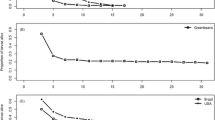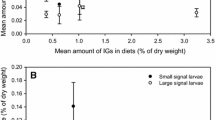Abstract
In this study we tested whether pyrrolizidine alkaloids (PAs) ofCynoglossum officinale serve as antifeedants against herbivores. Total PA N-oxide extracts of the leaves significantly deterred feeding by generalist herbivores. Specialist herbivores did not discriminate between food with high and low PA levels. Three PAs fromC. officinale, heliosupine, echinatine, and 3′-acetylechinatine, equally deterred feeding by the polyphagous larvae ofSpodoptera exigua. Although the plants mainly contain PAs in their N-oxide form, reduced PAs deterred feeding byS. exigua more efficiently than PA N-oxides. On rosette plants, the monophagous weevilMogulones cruciger significantly consumed more of the youngest leaves, which had the highest PA level and the highest nitrogen percentage. Larvae ofEthmia bipunctella, which are oligophagous within the Boraginaceae, did not discriminate between leaves. All generalist herbivores tested significantly avoided the youngest leaves with the highest PA levels. In the field, the oldest leaves also were relatively more damaged by herbivores than the youngest leaves. It is hypothesized that the skewed distribution of PAs over the leaves of rosette plants reflects optimal defense distribution within the plant.
Similar content being viewed by others
References
Aerts, R.J., Stoker, A., Beishuizen, M., Jaarsma, I., Van de Heuvel, M., Van der Meijden, E., andVerpoorte, R. 1992. Detrimental effects ofCinchona leaf alkaloids on larvae of the polyphagous insectSpodoptera exigua.J. Chem. Ecol. 18:1955–1964.
Anonymous. 1989. Pyrrolizidine Alkaloids Health and Safety Guide. World Health Organisation, Geneva.
Bentley, M.D., Leonard, D.E., Stoddard, W.F., andZalkow, L.H. 1984. Pyrrolizidine alkaloids as feeding deterrents for spruce budworm,Choristoneura fumifera Lepidoptera: Tortricidae).Ann. Entomol. Soc. Am. 77:393–397.
Berenbaum, M.R. 1985. Brementown revisited: Interactions among allelochemicals in plants, pp. 139–169,in G.A. Cooper-Driver, T. Swain, and E.E. Conn (eds.). Chemically Mediated Interactions between Plants and Herbivores. Plenum Press, New York.
Bernays, E.A., andChapman, R.F. 1977. Deterrent chemicals as a basis of oligophagy inLocusta migratoria L.Ecol. Entomol. 2:1–18.
Cates, R.G. 1980. Feeding patterns of monophagous, oligophagous, and polyphagous insect herbivores: the effect of resource abundance and plant chemistry.Oecologia 46:22–31.
Chapman, H.D., andPratt, P.F. 1961. Methods of analysis for soils, plants and waters. Division of Agricultural Sciences, University of California.
Colonelli, E. 1986. Note sistematici e sinonimiche su alcuni Ceutorhynchinae (Coleoptera, Curculionidae).Fragm. Entomol. 18:419–439.
De Jong, T.J., Klinkhamer, P.G.L., andBoorman, L.A. 1990. Biological Flora of the British Isles.Cynoglossum officinale L.J. Ecol. 78:1123–1144.
Dieckmann, L. 1972. Beiträge zur Insektenfauna der DDR: Coleoptera—Curculionidae: Ceutorhynchinae.Beitr. Entomol. 22:3–128.
Dreyer, D.L., Jones, K.C., andMolyneux, R.J. 1985. Feeding deterrency of some pyrrolizidine, indolizidine, and quinolizidine alkaloids towards pea aphid (Acyrthosiphon pisum) and evidence for phloem transport of indolizidine alkaloid swainsonine.J. Chem. Ecol. 11:1045–1051.
Ehrlich, P.R., andRaven, P.H. 1964. Butterflies and plants. A study in coevolution.Evolution 18:586–608.
Fraenkel, G.S. 1959. The raison d'être of secondary plant substances.Science 129:1466–1470.
Freese, A. 1990. Weed projects for Canada. Hound's tongue (Cynoglossum officinale L.). Work in Europe in 1990. CAB Int. Inst. Biol. Cont. Report, Delemont, Switzerland.
Gittenberger, E., Backhuys, W., andRipken, T.E.J. 1970. De landslakken van Nederland. K.N.N.V., Amsterdam.
Greimer, K. 1900. Giftig wirkende Boragineenalkaloide.Arch. Pharm. 1900:505–531.
Gustafsson, A., andGadd, I. 1965. Mutations and crop improvement. II. The genusLupinus (Leguminosae).Hereditas 53:15–39.
Harborne, J.B. 1988. Introduction to Ecological Biochemistry, 3rd ed. Academic Press, London.
Harper, J.L. 1989. The value of a leaf.Oecologia 80:53–58.
Hartmann, T. 1991. Alkaloids, pp. 79–12,in G.A. Rosenthal, and M.R. Berenbaum (eds.). Herbivores. Their Interaction with Secondary Plant Metabolites, Vol. I: The Chemical Participants. Academic Press, San Diego.
Hartmann, T., andWitte, L. 1994. Chemistry, biology and chemoecology of the pyrrolizidine alkaloids, pp. 155–233,in S.W. Pelletier (ed.). Alkaloids: Chemical and Biological Perspectives, Vol. 9. Pergamon Press Elmsford, New York, In press.
Hartmann, T., andZimmer, M. 1986. Organ specific distribution and accumulation of pyrrolizidine alkaloids during the life history of two annualSenecio species.J. Plant Physiol. 112:67–80.
Hartmann, T., Ehmke, A., Eilert, U., Von Borstel, K., andTheuring, C., 1989. Sites of synthesis, translocation and accumulation of pyrrolizidine alkaloid N-oxides inSenecio vulgaris L.Planta 177:98–107.
Heath, J. 1983. The Moths and Butterflies of Great Britain and Ireland, Vol. 10: Noctuidae (Cuculliinae to Hypeninae) and Agiristidae. Harley Books, Essex.
Hengauer, R. 1964. Chemotaxonomie der Pflanzen, Vol. III. Birkhäuser Verlag, Basel.
Heijerman, T. 1993. Naamlijst van de snuitkevers van Nederland en het omliggende gebied (Curculionoidae: Curculinoidae, Apionidae, Attelabidae, Urodontidae, Anthribidae en Nemonychidae).Ned. Faun. Med. 5:19–46.
Hodkinson, I.D., andHughes, M.K. 1982. Insect Herbivores. Chapman and Hall, London.
Hunter, W.B., andUllman, D.E. 1989. Analysis of mouthpart movements during feeding ofFrankliniella occidentalis (Pergande) andF. schultzei Trybom (Thysanoptera: Thripidae).Int. J. Insect Morphol. Embryol. 18:161–171.
Jones, C.G. 1983. Phytochemical variation, colonization, and insect communities: The case of bracken fern (Pteridium aquilinum), pp. 513–558,in R.F. Denno, and M.S. McClure (eds.). Variable Plants and Herbivores in Natural and Managed Systems. Academic Press, New York.
Krug, E., andProksch, P. 1993. Influence of dietary alkaloids on survival and growth ofSpodoptera littoralis.Biochem. Syst. Ecol. 21:749–756.
Mattocks, A.R. 1967. Spectrophotometric determination of unsaturated pyrrolizidine alkaloids.Anal. Chem. 39:443–447.
Mattocks, A.R. 1986. Chemistry and Toxicology of Pyrrolizidine Alkaloids. Academic Press, London.
Minkenberg, O.P.J.M., andvan Lenteren, J.C. 1986. The leaf-minersLyriomyza bryoniae andL. trifolii (Diptera: Agromyzidae), their parasites and host plants: A review.Agric. Univ. Wageningen Papers 86–2:1–50.
Molyneux, R.J., andRoitman, J.N. 1980. Specific detection of pyrrolizidine alkaloids on thinlayer chromatograms.J. Chromatogr. 195:412–415.
Mooney, H.A., andGulmon, S.L. 1982. Constraints on leaf structure and function in reference to herbivory.BioScience 32:198–206.
Prins, A.H., andLaan, R.M. 1988. Do plant characteristics influence the numbers ofEthmia bipunctella F. onCynoglossum officinale L.? Proceedings, 40th International Symposium on Crop Protection. Gent, Belgium. pp. 1409–1415.
Prins, A.H., andNell, H.W. 1990. Positive and negative effects of herbivory on the population dynamics ofSenecio jacobaea L. andCynoglossum officinale L.Oecologia 83:325–335.
Prins, A.H., Nell, H.W., andKlinkhamer, P.G.L. 1992. Size-dependent root herbivory onCynoglossum officinale L.Oikos 65:409–413.
Raupp, M.J., andDenno, R.F. 1983. Leaf age as a predictor of herbivore distribution, pp. 91–124,in R.F. Denno and M.S. McClure (eds.). Variable Plants and Herbivores in Natural and Managed Systems. Academic Press, New York.
Sattler, K. 1967. Microlepidoptera palaearctica. Zweiter Band: Ethmiidae. H.G. Amsel, G. Frantisek, and H. Reisser (eds.). G. Fromme & Co., Vienna.
Scriber, J.M. 1984. Host plant suitability, pp. 159–202,in W.J. Bell and R.T. Cardé (eds.). Chemical Ecology of Insects. Sinauer Associates, Sunderland, Massachusetts.
Sokal, R.R., andRohlf, F.J. 1981. Biometry, 2nd ed. W.H. Freeman, New York.
Soldaat, L.L., andvan der Meijden, E. 1990. Nutritional ecology of the monophagous cinnabar moth.Symp. Biol. Hung. 39:535–536.
Speiser, B., Harmatha, J., andRowell-Rahier, M. 1992. Effects of pyrrolizidine alkaloids and sesquiterpenes on snail feeding.Oecologia 91:257–265.
Sykulska, Z. 1962. The investigation of alkaloids ofCynoglossum officinale L.Acta Pol. Pharm. 19:183–184.
van Dam, N.M., van der Meijden, E., andVerpoorte, R. 1993. Induced responses in three alkaloid containing plant species.Oecologia 95:425–430.
van Dam, N.M., Verpoorte, R., andvan der Meijden, E. 1994. Extreme differences in pyrrolizidine alkaloid levels between leaves ofCynoglossum officinale L.Phytochemistry 37:1013–1016.
Van Dam, N.M., Witte, L., Theuring, C., andHartmann, T. 1995. Distribution, biosynthesis, and turnover of pyrrolizidine alkaloids inCynoglossum officinale L.Phytochemistry. In press.
Van der Meijden, E., van Wijk, C.A.M., andKooi, R.E. 1991. Population dynamics of the cinnabar moth (Tyria jacobaeae): Oscillations due to food limitation and local extinction risks.Neth. J. Zool. 41:158–173.
Wink, M. 1993. Allelochemical properties or the raison d'être of alkaloids, pp. 1–118,in G.A. Cordell (ed.). The Alkaloids, Vol. 43. Academic Press, San Diego.
Witte, L., Rubiolo, P., Bicchi, C., andHartmann, T. 1993. Comparative analysis of pyrrolizidine alkaloids from natural sources by gas chromatography-mass spectrometry.Phytochemistry 32:187–196.
Zangerl, A.R., andBazzaz, F.A. 1992. Theory and pattern in plant defense allocation, pp. 363–391,in S. Fritz, and E.L. Simms (eds.). Plant Resistance to Herbivores and Pathogens. The University of Chicago Press, Chicago.
Author information
Authors and Affiliations
Rights and permissions
About this article
Cite this article
van Dam, N.M., Vuister, L.W.M., Bergshoeff, C. et al. The “Raison D'être” of pyrrolizidine alkaloids inCynoglossum officinale: Deterrent effects against generalist herbivores. J Chem Ecol 21, 507–523 (1995). https://doi.org/10.1007/BF02033698
Received:
Accepted:
Issue Date:
DOI: https://doi.org/10.1007/BF02033698




